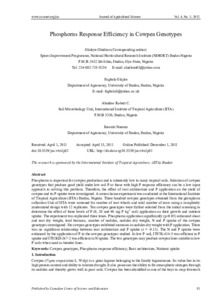| dc.contributor.author | Olaleye, O. |
| dc.contributor.author | Fagbola, O. |
| dc.contributor.author | Abaidoo, R.C. |
| dc.contributor.author | Ikeorah, N. |
| dc.date.accessioned | 2019-12-04T11:08:22Z |
| dc.date.available | 2019-12-04T11:08:22Z |
| dc.date.issued | 2012-01 |
| dc.identifier.citation | Olaleye, O., Fagbola, O., Abaidoo, R.C. & Ikeorah, N. (2012). Phosphorus response efficiency in cowpea genotypes. Journal of Agricultural Science, 4(1), 81-90. |
| dc.identifier.issn | 1916-9752 |
| dc.identifier.uri | https://hdl.handle.net/20.500.12478/1806 |
| dc.description | Published by Canadian Center of Science and Education |
| dc.description.abstract | Phosphorus is important for cowpea production and is inherently low in many tropical soils. Selection of cowpea genotypes that produce good yield under low soil P or those with high P response efficiency can be a low input
approach in solving this problem. Therefore, the effect of root architecture and P application on the yield of cowpea and its P uptake were investigated. A screen house experiment was conducted at the International Institute
of Tropical Agriculture (IITA) Ibadan, Nigeria. Three hundred cowpea genotypes obtained from the germplasm collection Unit of IITA were screened for number of root whorls and total number of roots using a completely
randomized design with 12 replicates. Ten cowpea genotypes were further selected from the initial screening to determine the effect of three levels of P (0, 20 and 40 mg P kg-1 soil) application on their growth and nutrient
uptake. The experiment was replicated three times. Phosphorus application significantly (p0.05) enhanced shoot and root dry weight, total biomass, number of nodules, nodules dry weight, N and P uptake of the cowpea
genotypes investigated. Six cowpea genotypes exhibited increases in nodules dry weight with P application. There was no significant relationship between root architecture and P uptake (r = -0.13). The N and P uptake were enhanced by the application of P in the cowpea genotypes studied. In low P soil, IT97K-414-5 was efficient in P uptake and IT92KD-267-2 was efficient in N uptake. The two genotypes may produce cowpea lines suitable in low
P soils when used as breeder lines. |
| dc.format.extent | 81-90 |
| dc.language.iso | en |
| dc.subject | Cowpeas |
| dc.subject | Genotypes |
| dc.subject | Phosphorus |
| dc.subject | Efficiency |
| dc.subject | Root |
| dc.subject | Architecture |
| dc.title | Phosphorus response efficiency in cowpea genotypes |
| dc.type | Journal Article |
| dc.description.version | Peer Review |
| cg.contributor.crp | Grain Legumes |
| cg.contributor.affiliation | National Horticultural Research Institute, Nigeria |
| cg.contributor.affiliation | University of Ibadan |
| cg.contributor.affiliation | International Institute of Tropical Agriculture |
| cg.coverage.region | Africa |
| cg.coverage.region | West Africa |
| cg.coverage.country | Nigeria |
| cg.authorship.types | CGIAR and developing country institute |
| cg.iitasubject | Cowpea |
| cg.iitasubject | Grain Legumes |
| cg.iitasubject | Genetic Improvement |
| cg.iitasubject | Plant Genetic Resources |
| cg.journal | Journal of Agricultural Science |
| cg.howpublished | Formally Published |
| cg.accessibilitystatus | Limited Access |
| local.dspaceid | 83258 |
| cg.identifier.doi | http://dx.doi.org/10.5539/jas.v4n1p81 |

